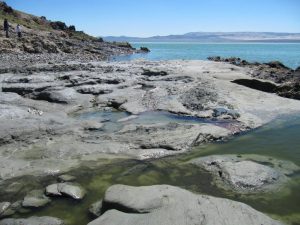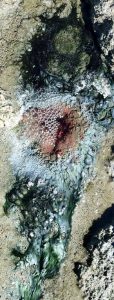26 December 2016
Hot springs in California host snapshot of early Earth conditions
Posted by Lauren Lipuma

Water from the hot spring sampling sites on Paoha Island mudflats combine together in a large pool before flowing over the edge into Mono Lake. New research shows conditions in the hot alkaline springs could be similar to Earth’s pre-oxygen environment billions of years ago.
Credit: Ian S. Foster.
By Devika G. Bansal
Conditions in the hot alkaline springs of Paoha Island in Mono Lake, California, could be similar to Earth’s pre-oxygen environment billions of years ago, researchers reported at the 2016 American Geophysical Union Fall Meeting in San Francisco. Studying the springs could help scientists better understand microbial biodiversity as it evolved in the early Earth atmosphere.
Formed about 450 years ago, the young Paoha Island is host to a number of chemically unusual hot springs—their waters are alkaline, thrice as salty as seawater, rich in arsenic and have virtually no oxygen. The springs harbor oxygen-producing cyanobacteria living right next to microbes for which oxygen is poison. Chemistry of the water and the unique bacterial community it supports hint at Earth’s environment in the Archean-Proterozoic era when oxygen first appeared onto the scene, researchers noted.
Eight years ago, scientists at the U.S. Geological Survey discovered odd bacteria in the island’s hot springs that use the toxic arsenic for anoxygenic photosynthesis, which does not make oxygen in the process. This summer, a team of four graduate students attending the International Geobiology Course in Los Angeles set out to identify what else might be living next to the unusual arsenic microbes. On a late June morning, they arrived on the southeastern shore of the fuming island to scoop up some hot spring dwellers.
“When you get off the boat, it smells like a gas station,” said Andrew Hyde, a graduate student at University of North Carolina, Chapel Hill and co-author of the study. “It’s like stepping on another planet—it’s the weirdest place I’ve ever been.”
In a total of five hours, the team collected bacterial samples from the lake and two hot spring sites, where microbes congregated in red and green microbial mats—layers of hundreds of millions of microbes packed together in the alkaline mudflats. Over the next three weeks, the researchers used mathematical modeling and DNA sequencing analyses to characterize the water chemistry and the microbial communities living in the mats.

This hot spring has red microbial mats dominate close to its source, transitioning into a white mat dominated by sulfur oxidizing organisms, followed by the deep green mat dominated by oxygenic photosynthetic cyanobacteria.
Credit: Ian S. Foster.
“We did a lot of chemistry and math to figure out the type of metabolism that’s most favorable in these environments,” said Ian Foster, a graduate student at the European Institute for Marine Studies in Brest, France and lead author of the new study.
Most microbes in the hot springs preferred breathing sulfide and methane, Foster said. The team found light-powered microbes in both the red and green mats, but the microbes had distinct signatures. Green films were colonies of oxygen-producing cyanobacteria. Red films, on the other hand, harbored purple arsenic-using microbes for which oxygen is toxic.
The team sequenced total DNA from the mats and found genes for photosynthesis and arsenic resistance. However, almost 95% of genes were largely unknown, hinting at the uniqueness of these bacterial communities. At least one of the unknown genes, Hyde noted, could be involved in arsenic metabolism. “It would be really interesting to get into that 95% and see what else is in there,” he said.
A key discovery of the work was finding bacteria respiring oxygen living side-by-side to microbes for which it is poison, the researchers said. This is in contrast to other examples of the two microbial communities living together, in which case cyanobacteria live on top so the oxygen they produce floats up and away from the anoxygenic bacteria underneath, Foster noted.
“Finding these communities together side-by-side is very interesting because one should be killing the other, but the environment itself is keeping that from happening,” Foster said. It turns out the chemistry of the system keeps the water anoxic, or oxygen-free: As cyanobacteria exhale oxygen into the spring water, the sulfur-oxidizing bacteria in the environment reduce its builds up. “So instead of seeing these two types living above and below we see them living side-by-side,” Foster explained.
Conditions in the hot springs of Paoha Island could be the same as those during the Great Oxygenation Event 2.3 billion years ago when the first oxygen-breathing organisms evolved in microbial mats dominated by anoxygenic bacteria, said Cansu Demirel, a graduate student at the Istanbul Technical University and co-author of the study.
“I think the microbial community [in the springs] is really unique,” said Tianmei Wang, a graduate student at Stanford University who was not involved in the study. “They also hope to find out some unknown genes for arsenic resistance, so I’m pretty excited to see their future work.”
—Devika G. Bansal is a graduate student in the Science Communication program at UC Santa Cruz.


 GeoSpace is a blog on Earth and space science, managed by AGU’s Public Information staff. The blog features posts by AGU writers and guest contributors on all sorts of relevant science topics, but with a focus on new research and geo and space sciences-related stories that are currently in the news.
GeoSpace is a blog on Earth and space science, managed by AGU’s Public Information staff. The blog features posts by AGU writers and guest contributors on all sorts of relevant science topics, but with a focus on new research and geo and space sciences-related stories that are currently in the news.
A small typo – it should be “U.S. Geological Survey”, not “Service.”
Nice feature! I’ll have to try and visit those on my next trip out to Mono Lake.
Thanks. Correcting now…